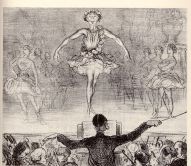Masculine Danseur?
 Even
before the French Revolution, there were concerns about the “manliness” of
the ballet profession and these anxieties became more pronounced as the
nineteenth century progressed. This often cited quote by Jules Janin (Garafola
1985),
written in 1840, provides a clear idea of what was considered manly and
what was
not (and the male dancer was definitely not):
Even
before the French Revolution, there were concerns about the “manliness” of
the ballet profession and these anxieties became more pronounced as the
nineteenth century progressed. This often cited quote by Jules Janin (Garafola
1985),
written in 1840, provides a clear idea of what was considered manly and
what was
not (and the male dancer was definitely not):
“…
a man, a frightful man, as ugly as you and I, a wretched fellow who
leaps about without knowing why, a creature specially made to carry a musket
and a sword and to wear a uniform. That this fellow should dance as a woman
does – impossible! That this bewhiskered individual who is a pillar
of the community, an elector, a municipal councilor, a man whose business
is to make and unmake laws, should come with a hat with a waving plume
amorously caressing his cheek, a frightful danseuse of the male sex, come
to pirouette in the best place while the pretty ballet girls stand respectfully
at a distance – this is surely impossible and intolerable." (p.
37-38)
A lithograph by Honoré Daumier captures these
sentiments in visual form, the “abnormality” of the danseur
evoked by this figure’s awkward stance and scrawny physique. The
ballet clearly was not the natural environment of a self-respecting “man.” The
pomp and ceremony with which masculinity had displayed itself during the
previous century was supplanted
by the image of the modest, frugal and industriousself-made
man in the nineteenth century
(Kuchta 1996).